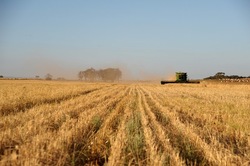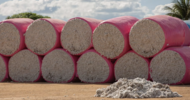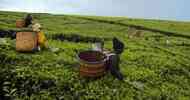Bloomberg | 30 January 2012
By Angus Whitley
Winston Heywood ended a 200-year family history when he sold his parched wheat fields to a fund managed by U.S. investor Westchester Group Investment Management Inc. for more than A$6 million ($6.4 million).
“They offered me the money I could live off for the rest of my life,” said the 62-year-old, who in August left for the New South Wales coastal town of Coffs Harbour after enduring his driest season since 2000. “My kids didn’t want to go through the ups and downs I went through.”
At least four other funds are seeking A$1.6 billion to buy similar assets in Australia, lured by fresh rain, the prospect of bumper crops, and land prices that have dropped 20 percent nationwide, and in some areas have fallen by half, since the end of 2007. Now, three years after billionaire James Packer sold off cattle ranches larger than the Netherlands, rural land prices may have bottomed, according to Colliers International.
The influx has pushed lawmakers to consider legislation that would increase scrutiny of overseas purchases after foreign ownership of land almost doubled since 1984. The funds also need to defy a history of farming ventures that have struggled to reward investors.
Laguna Bay Pastoral Co., the Australian fund advised by commodities investor Jim Rogers that’s seeking to raise A$600 million, is targeting annual returns of about 10 percent, helped by the appetite of a growing global population.
“I am bullish on all agriculture, everything from sugar to rice, to wheat to corn,” said Rogers, the Singapore-based commodities investor who created the Rogers International Commodity Index in 1997. “Australia has a lot of land and people who understand agriculture, and who are good farmers.”
‘Unprecedented Interest’
Anglo-Australian Southern Agricultural Resources is seeking A$150 million in London to spend in Australia, while Sustainable Agriculture Fund, based in Melbourne, wants A$250 million. Queensland’s PrimeAg (PAG) Australia Ltd., whose farms span an area wider than Texas, is raising A$600 million.
“There’s unprecedented interest, and I’ve been in the business 35 years,” said Peter Corish, managing director of PrimeAg. “The outlook for production is much improved as a result of coming out of the long drought in 2009 and early 2010.”
Still, foreign buyers who attempt to run Australian assets without local expertise may struggle, said David Leyonhjelm at Baron Strategic Services, a Sydney-based agricultural consultancy he set up in 1989.
“Unless they employ good managers who know how to run a farm under Australian conditions, they’ll lose their shirt,” said Leyonhjelm. “The history of investment in agriculture in Australia is poor return on capital.”
Commodities Index
PrimeAg, which plans to start buying properties for its new fund in the first half of 2012, closed at A$1.05 in Sydney trading yesterday. It sold shares at A$2 each in December 2007. Australian Agricultural Co. (AAC), the Queensland cattle breeder formed in 1824, has lost 61 percent since January 2008.
The Commodity Research Bureau/Reuters US Spot Foodstuff index fell 1.1 percent in 2011, beating the 7.6 percent decline in the MSCI World index.
As Illinois-based asset manager Westchester adds to its 400 farms worldwide, a 12-strong team in Australia is scouting for more land, said Matt Bull, a former Rabobank executive who heads the local business.
“We’d like to acquire a few properties in 2012,” said Bull, who is based in the rural town of Wagga Wagga, a five-hour drive southwest from Sydney.
No Successor
According to data on Westchester’s website, investors have fared better wagering on agriculture than on the S&P 500 index in the past four decades. Between 1970 and 2009, annual returns from Illinois farmland averaged 10.25 percent, said Westchester, whose New York-based parent, TIAA-CREF, manages $440.7 billion of assets. The stock index advanced an average 8 percent.
Heywood’s final drought was so severe that he didn’t even attempt to grow a crop. Without a successor among his four children, the offer for the 6,750-acre (2,732 hectares) farm northwest of Moree was more than a local suitor would ever pay, he said, declining to give an exact sale price.
Westchester’s Bull declined to confirm the deal.
“It’s a cyclical industry and we think it’s bottomed,” said Tim Altschwager, the Adelaide-based senior executive of rural and agribusiness investment sales for Colliers. “That’s a bit of the reason why these investment funds are getting interested.”
He said last year was the best for sales in a decade.
Some asset managers, including Westchester, buy land mostly to lease while some aggregate plots with nearby assets. Others invest jointly with the owners.
Few Winners
In Australia, the world’s driest inhabited continent, the best-performing farms are a profitable minority, according to a survey in April by the Australian Bureau of Agricultural and Resource Economics and Sciences. The top 25 percent of grain, seed, crop and livestock farms bring in 85 percent of profits and achieved an average annual return of 7 percent in the five years to 2010, said Abares, as the government department is known.
“The only way to achieve elite returns is to joint venture with elite farmers,” said Tim McGavin, Laguna Bay’s chief investment officer, on the eve of an overseas trip to court investors including Asian sovereign wealth funds. “Earnings are volatile, so you have to be there for a long time.”
Early Exporter
Laguna Bay, with east-coast offices in Sydney, Noosa and Brisbane, plans to buy properties in New South Wales this year and lock in investors for a decade, he said.
Claimed by Britain in 1788 as a penal colony, Australia has been an agricultural exporter since convicts started clearing bush and scrub to grow wheat and rear livestock.
Two centuries later, the country produces more than twice the food consumed by its 22.8 million population, according to Abares. Wheat is the largest agricultural export, making Australia the second-biggest overseas seller after the U.S., according to data compiled by Bloomberg.
La Nina-linked weather brought record rainfall to eastern parts of Australia in 2010, replenishing dams to irrigate cotton crops, and last year was the third-wettest on record, the Bureau of Meteorology said. The nation, which typically suffers a severe drought every 18 years, is set to produce the biggest winter crop ever with unprecedented wheat and cotton harvests, Abares said in December.
Investor Education
Even with those forecasts, it can be tough to persuade investors to part with money, according to Macquarie Group Ltd. (MQG), the Australian investment bank that runs a fund managing more than 3 million hectares of land for sheep and cattle.
“This is the conundrum: it’s a 10,000-year-old sector that people are just learning about,” said Tim Hornibrook, an executive director at the Sydney-based bank who helps run the fund. “It takes time to educate the market.”
As word spreads that funds are buying, farmers may hold out for higher offers, said Arthur Apted, chairman of Sustainable Agriculture Fund, which owns farms in Tasmania, Victoria and New South Wales.
“It may tighten the market up,” said Apted. The total he’s seeking from investors -- A$250 million -- would be almost twice the size of its first fund in 2009.
China’s Cofco in July won control of Tully Sugar Ltd., and Thailand’s Mitr Phol Sugar Corp. agreed to buy Queensland’s MSF Sugar Ltd. (MSF) in November with a bid valuing the company at A$313 million. Chinese buyers have snapped up vineyards in the Hunter Valley north of Sydney, and half of Australia’s 23 licensed wheat exporters are foreign owned, according to Abares.
Concerned Farmer
The arrival of corporate or overseas landowners stems from the need to till ever-larger areas in a bid to turn a profit, said David Kingston, who farms wheat, canola and sheep on an 8,000-acre property near Wagga Wagga.
“Around here, everyone would buy their next-door neighbor in a breath if they could,” said Kingston, 40, who has almost tripled his family’s land since 1994. “The margins aren’t big enough to be small. But my biggest concern is overseas investors coming in and Australians not benefiting.”
The proportion of agricultural land wholly or part-owned by overseas entities almost doubled to 11 percent at the end of 2010 from 5.9 percent in 1984, according to government data. In South Australia, the proportion almost tripled to 12 percent and in the Northern Territory, it rose to 24 percent from 18 percent.
Greater Scrutiny
A bill to enforce greater scrutiny of foreign land investment was introduced in the Australian Senate in November 2010 by independent Senator Nick Xenophon and Greens Senator Christine Milne. They want purchases of agricultural land of more than A$5 million to require approval from the Foreign Investment Review Board, rather than the current threshold of 15 percent of any Australian business valued above A$231 million. The bill has been debated and amended in the Senate and is yet to be voted upon.
The government on Jan. 18 defended the benefits of foreign investment in agriculture, releasing a report it commissioned that said overseas capital boosts production and creates jobs in rural communities. Buying tracts of Australian farmland is unlikely to significantly help foreign nations improve their food security, the report said.
‘Fear of Foreigners’
“Concessions to concerns about sovereignty, distrust or fear of foreigners are likely to come at an economic cost to countries that restrict the inflow of foreign capital,” Abares said in the report.
The marriage of capital and farmland can suit both parties, said Andrew Parkes, managing director of Customised Farm Management Pty, an agricultural consultancy formed in 2008 that’s helping Southern Agricultural Resources raise funds from U.S., U.K. and Asian investors.
Investing in properties that offer potential, rather than backing top performers, may generate the best returns, he said.
“Capital would enable them to get to that top level,” said Moree-based Parkes. “Some of them are willing sellers and are looking to head to the coast and put their feet up.”
Heywood, the former Moree farmer, looks to the sea from his second-floor balcony in Coffs Harbour and contemplates the life he left 500 kilometers (311 miles) inland.
“It has come to an end,” he says. “My family will never be able to buy it back.”
To contact the reporter on this story: Angus Whitley in Sydney at [email protected]
To contact the editor responsible for this story: Philip Lagerkranser at [email protected]
By Angus Whitley
Winston Heywood ended a 200-year family history when he sold his parched wheat fields to a fund managed by U.S. investor Westchester Group Investment Management Inc. for more than A$6 million ($6.4 million).
“They offered me the money I could live off for the rest of my life,” said the 62-year-old, who in August left for the New South Wales coastal town of Coffs Harbour after enduring his driest season since 2000. “My kids didn’t want to go through the ups and downs I went through.”
At least four other funds are seeking A$1.6 billion to buy similar assets in Australia, lured by fresh rain, the prospect of bumper crops, and land prices that have dropped 20 percent nationwide, and in some areas have fallen by half, since the end of 2007. Now, three years after billionaire James Packer sold off cattle ranches larger than the Netherlands, rural land prices may have bottomed, according to Colliers International.
The influx has pushed lawmakers to consider legislation that would increase scrutiny of overseas purchases after foreign ownership of land almost doubled since 1984. The funds also need to defy a history of farming ventures that have struggled to reward investors.
Laguna Bay Pastoral Co., the Australian fund advised by commodities investor Jim Rogers that’s seeking to raise A$600 million, is targeting annual returns of about 10 percent, helped by the appetite of a growing global population.
“I am bullish on all agriculture, everything from sugar to rice, to wheat to corn,” said Rogers, the Singapore-based commodities investor who created the Rogers International Commodity Index in 1997. “Australia has a lot of land and people who understand agriculture, and who are good farmers.”
‘Unprecedented Interest’
Anglo-Australian Southern Agricultural Resources is seeking A$150 million in London to spend in Australia, while Sustainable Agriculture Fund, based in Melbourne, wants A$250 million. Queensland’s PrimeAg (PAG) Australia Ltd., whose farms span an area wider than Texas, is raising A$600 million.
“There’s unprecedented interest, and I’ve been in the business 35 years,” said Peter Corish, managing director of PrimeAg. “The outlook for production is much improved as a result of coming out of the long drought in 2009 and early 2010.”
Still, foreign buyers who attempt to run Australian assets without local expertise may struggle, said David Leyonhjelm at Baron Strategic Services, a Sydney-based agricultural consultancy he set up in 1989.
“Unless they employ good managers who know how to run a farm under Australian conditions, they’ll lose their shirt,” said Leyonhjelm. “The history of investment in agriculture in Australia is poor return on capital.”
Commodities Index
PrimeAg, which plans to start buying properties for its new fund in the first half of 2012, closed at A$1.05 in Sydney trading yesterday. It sold shares at A$2 each in December 2007. Australian Agricultural Co. (AAC), the Queensland cattle breeder formed in 1824, has lost 61 percent since January 2008.
The Commodity Research Bureau/Reuters US Spot Foodstuff index fell 1.1 percent in 2011, beating the 7.6 percent decline in the MSCI World index.
As Illinois-based asset manager Westchester adds to its 400 farms worldwide, a 12-strong team in Australia is scouting for more land, said Matt Bull, a former Rabobank executive who heads the local business.
“We’d like to acquire a few properties in 2012,” said Bull, who is based in the rural town of Wagga Wagga, a five-hour drive southwest from Sydney.
No Successor
According to data on Westchester’s website, investors have fared better wagering on agriculture than on the S&P 500 index in the past four decades. Between 1970 and 2009, annual returns from Illinois farmland averaged 10.25 percent, said Westchester, whose New York-based parent, TIAA-CREF, manages $440.7 billion of assets. The stock index advanced an average 8 percent.
Heywood’s final drought was so severe that he didn’t even attempt to grow a crop. Without a successor among his four children, the offer for the 6,750-acre (2,732 hectares) farm northwest of Moree was more than a local suitor would ever pay, he said, declining to give an exact sale price.
Westchester’s Bull declined to confirm the deal.
“It’s a cyclical industry and we think it’s bottomed,” said Tim Altschwager, the Adelaide-based senior executive of rural and agribusiness investment sales for Colliers. “That’s a bit of the reason why these investment funds are getting interested.”
He said last year was the best for sales in a decade.
Some asset managers, including Westchester, buy land mostly to lease while some aggregate plots with nearby assets. Others invest jointly with the owners.
Few Winners
In Australia, the world’s driest inhabited continent, the best-performing farms are a profitable minority, according to a survey in April by the Australian Bureau of Agricultural and Resource Economics and Sciences. The top 25 percent of grain, seed, crop and livestock farms bring in 85 percent of profits and achieved an average annual return of 7 percent in the five years to 2010, said Abares, as the government department is known.
“The only way to achieve elite returns is to joint venture with elite farmers,” said Tim McGavin, Laguna Bay’s chief investment officer, on the eve of an overseas trip to court investors including Asian sovereign wealth funds. “Earnings are volatile, so you have to be there for a long time.”
Early Exporter
Laguna Bay, with east-coast offices in Sydney, Noosa and Brisbane, plans to buy properties in New South Wales this year and lock in investors for a decade, he said.
Claimed by Britain in 1788 as a penal colony, Australia has been an agricultural exporter since convicts started clearing bush and scrub to grow wheat and rear livestock.
Two centuries later, the country produces more than twice the food consumed by its 22.8 million population, according to Abares. Wheat is the largest agricultural export, making Australia the second-biggest overseas seller after the U.S., according to data compiled by Bloomberg.
La Nina-linked weather brought record rainfall to eastern parts of Australia in 2010, replenishing dams to irrigate cotton crops, and last year was the third-wettest on record, the Bureau of Meteorology said. The nation, which typically suffers a severe drought every 18 years, is set to produce the biggest winter crop ever with unprecedented wheat and cotton harvests, Abares said in December.
Investor Education
Even with those forecasts, it can be tough to persuade investors to part with money, according to Macquarie Group Ltd. (MQG), the Australian investment bank that runs a fund managing more than 3 million hectares of land for sheep and cattle.
“This is the conundrum: it’s a 10,000-year-old sector that people are just learning about,” said Tim Hornibrook, an executive director at the Sydney-based bank who helps run the fund. “It takes time to educate the market.”
As word spreads that funds are buying, farmers may hold out for higher offers, said Arthur Apted, chairman of Sustainable Agriculture Fund, which owns farms in Tasmania, Victoria and New South Wales.
“It may tighten the market up,” said Apted. The total he’s seeking from investors -- A$250 million -- would be almost twice the size of its first fund in 2009.
China’s Cofco in July won control of Tully Sugar Ltd., and Thailand’s Mitr Phol Sugar Corp. agreed to buy Queensland’s MSF Sugar Ltd. (MSF) in November with a bid valuing the company at A$313 million. Chinese buyers have snapped up vineyards in the Hunter Valley north of Sydney, and half of Australia’s 23 licensed wheat exporters are foreign owned, according to Abares.
Concerned Farmer
The arrival of corporate or overseas landowners stems from the need to till ever-larger areas in a bid to turn a profit, said David Kingston, who farms wheat, canola and sheep on an 8,000-acre property near Wagga Wagga.
“Around here, everyone would buy their next-door neighbor in a breath if they could,” said Kingston, 40, who has almost tripled his family’s land since 1994. “The margins aren’t big enough to be small. But my biggest concern is overseas investors coming in and Australians not benefiting.”
The proportion of agricultural land wholly or part-owned by overseas entities almost doubled to 11 percent at the end of 2010 from 5.9 percent in 1984, according to government data. In South Australia, the proportion almost tripled to 12 percent and in the Northern Territory, it rose to 24 percent from 18 percent.
Greater Scrutiny
A bill to enforce greater scrutiny of foreign land investment was introduced in the Australian Senate in November 2010 by independent Senator Nick Xenophon and Greens Senator Christine Milne. They want purchases of agricultural land of more than A$5 million to require approval from the Foreign Investment Review Board, rather than the current threshold of 15 percent of any Australian business valued above A$231 million. The bill has been debated and amended in the Senate and is yet to be voted upon.
The government on Jan. 18 defended the benefits of foreign investment in agriculture, releasing a report it commissioned that said overseas capital boosts production and creates jobs in rural communities. Buying tracts of Australian farmland is unlikely to significantly help foreign nations improve their food security, the report said.
‘Fear of Foreigners’
“Concessions to concerns about sovereignty, distrust or fear of foreigners are likely to come at an economic cost to countries that restrict the inflow of foreign capital,” Abares said in the report.
The marriage of capital and farmland can suit both parties, said Andrew Parkes, managing director of Customised Farm Management Pty, an agricultural consultancy formed in 2008 that’s helping Southern Agricultural Resources raise funds from U.S., U.K. and Asian investors.
Investing in properties that offer potential, rather than backing top performers, may generate the best returns, he said.
“Capital would enable them to get to that top level,” said Moree-based Parkes. “Some of them are willing sellers and are looking to head to the coast and put their feet up.”
Heywood, the former Moree farmer, looks to the sea from his second-floor balcony in Coffs Harbour and contemplates the life he left 500 kilometers (311 miles) inland.
“It has come to an end,” he says. “My family will never be able to buy it back.”
To contact the reporter on this story: Angus Whitley in Sydney at [email protected]
To contact the editor responsible for this story: Philip Lagerkranser at [email protected]














